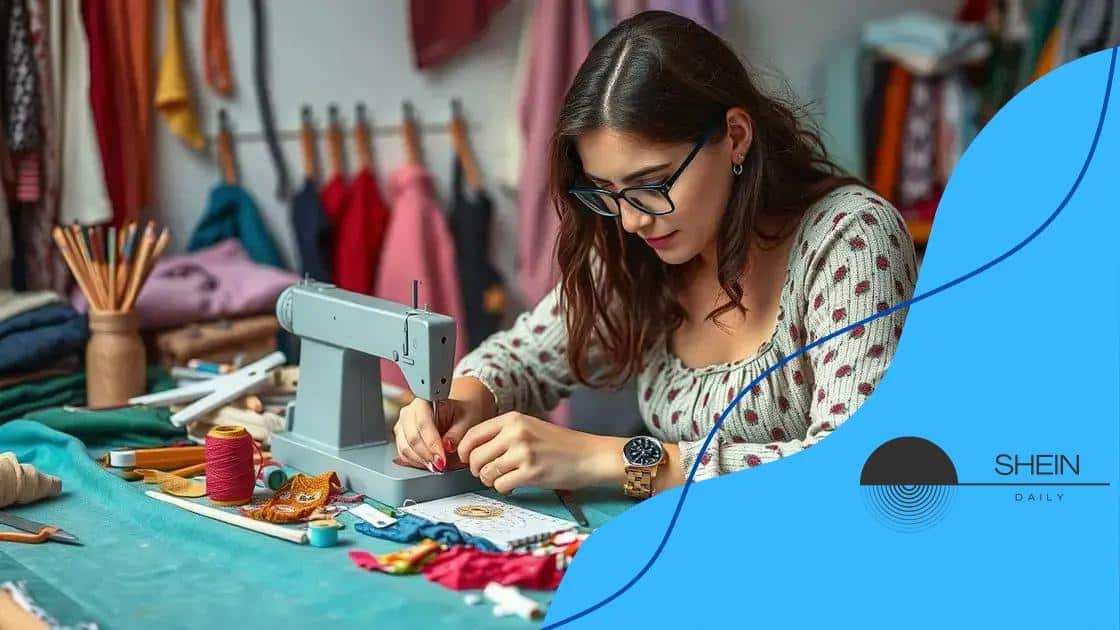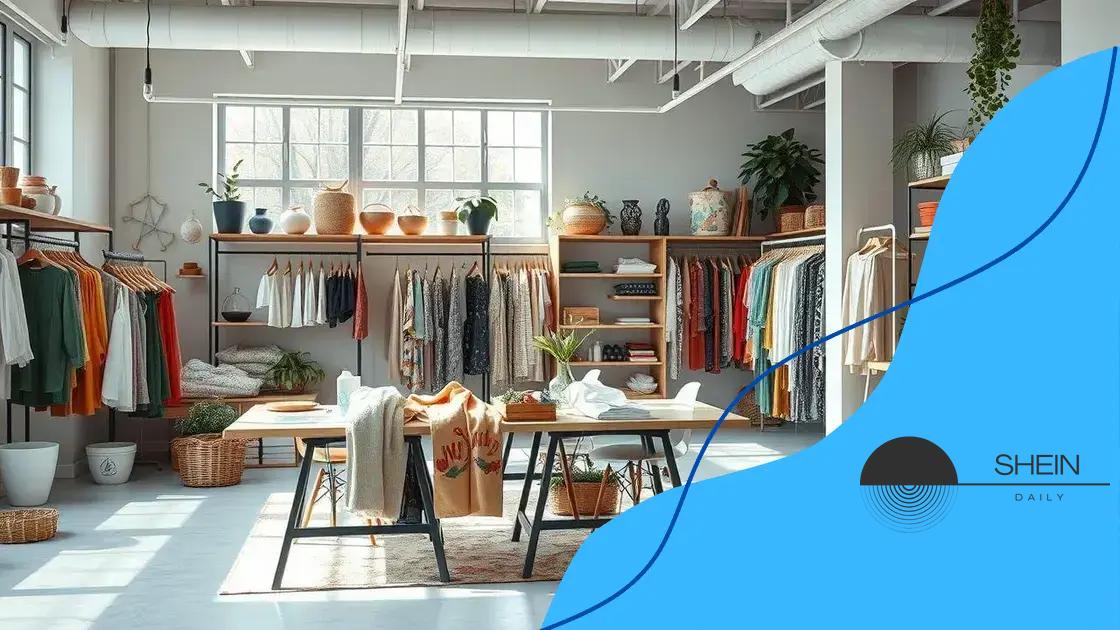Shein’s resources on upcycling and DIY fashion

Upcycling in fashion involves transforming discarded clothing into stylish new pieces, significantly reducing waste and promoting sustainability while allowing for unique personal expression.
Shein’s resources on upcycling and DIY fashion are paving the way for a new trend in sustainability. Are you curious about how to transform old garments into chic outfits? Let’s dive in!
Understanding upcycling in fashion
Upcycling in fashion is about turning old clothes into something new and stylish. This process not only reduces waste but also gives garments a second life. It encourages creativity and sustainability, which are essential in today’s fashion industry.
What is Upcycling?
Upcycling takes discarded items and transforms them into products of higher value. This means that rather than throwing away clothes, they are reimagined into unique pieces. It’s a way to express individuality while being environmentally conscious.
Benefits of Upcycling
There are numerous advantages to incorporating upcycling into your wardrobe:
- Reduces textile waste
- Encourages creativity and self-expression
- Promotes sustainable consumer habits
- Can save you money
As people become more aware of the environmental impact of fast fashion, they seek alternatives. Upcycling helps shift the focus to resourcefulness and personal style.
How to Start Upcycling
Starting your upcycling journey can be exciting. Consider looking in your closet for items you no longer wear. Simple projects might include:
- Turning an old t-shirt into a tote bag
- Altering a dress into a chic top
- Adding embellishments to revamp a jacket
These simple projects not only bring old clothes back to life but also become a fun way to spend your time. The possibilities are endless when you start to think outside the box!
Creative DIY fashion projects
Creative DIY fashion projects are a fantastic way to express your personality while being environmentally friendly. With a little imagination and some basic materials, you can transform old garments into something exciting and new. Let’s explore some fun project ideas!
Upcycled Denim
Denim is durable and versatile, making it perfect for upcycling. Consider turning old jeans into a stylish bag or a unique pair of shorts. You can also add fabric patches or embroidery to give them a fresh look. These small changes can make a huge difference.
- Create a denim tote bag from an old pair of jeans.
- Transform denim jackets with new buttons and patches.
- Cut and fray old jeans into trendy cutoff shorts.
These projects are not only fun but also practical, allowing you to reuse items that might otherwise end up in a landfill.
Transforming T-Shirts
Old t-shirts can become something extraordinary with just a bit of creativity. You can turn them into stylish tank tops, headbands, or even pillow covers. Reimagining t-shirts allows for endless possibilities and a unique style.
- Cut a t-shirt into a tank top with a twist.
- Create a colorful headband using t-shirt scraps.
- Make fun pillow covers for your bedroom.
These easy projects require minimal sewing skills, making them perfect for beginners. They highlight how DIY fashion can be fun and accessible to everyone.
Accessorizing with Upcycling
Don’t forget that accessories can also be made from upcycled materials! Items such as old jewelry, fabric scraps, and even broken items can be transformed into trendy pieces. A little creativity can lead to amazing results.
- Turn old jewelry into new statement pieces.
- Create fabric-covered bangles from scraps.
- Make a necklace using buttons and thread.
With easy-to-find materials and the right inspiration, the possibilities are endless. So gather your supplies and start creating!
How Shein supports sustainable practices

Shein is increasingly recognized for its efforts to support sustainable practices in the fashion industry. The company aims to reduce its environmental footprint while maintaining a strong appeal to style-conscious consumers. This commitment includes embracing eco-friendly measures throughout its supply chain.
Sustainable Materials
One of the key elements of Shein’s sustainability efforts is the use of sustainable materials. The brand is working to incorporate more fabrics made from recycled materials and organic fibers. This not only minimizes waste but also reduces the resource consumption typically associated with textile production.
- Utilizing recycled polyester in clothing lines.
- Integrating organic cotton for a lesser impact on the environment.
- Exploring innovative biodegradable materials.
By prioritizing these materials, Shein takes important steps toward reducing the environmental impact of its products.
Water Conservation Initiatives
Shein also emphasizes water conservation within its manufacturing processes. The company strives to implement techniques to reduce water usage during production. This is crucial, as traditional fashion manufacturing often consumes large amounts of water.
- Adopting water-saving technologies in textile production.
- Implementing closed-loop systems to recycle water.
- Educating suppliers on best water management practices.
These initiatives significantly contribute to more sustainable fashion production, helping to alleviate some of the pressure on our planet’s water resources.
Transparency and Ethical Practices
Another critical aspect of Shein’s sustainable approach is transparency. The brand recognizes the importance of sharing information about its supply chain. This includes disclosing the locations of factories and their working conditions. By doing so, Shein aims to promote ethical practices and accountability within the industry.
Shein encourages consumers to be aware of where their clothing comes from and the conditions under which it is produced. This transparency fosters a sense of trust and responsibility among shoppers.
Tips for incorporating upcycled pieces
Incorporating upcycled pieces into your wardrobe is a creative and sustainable choice. You can mix these unique items with your existing clothing for a fresh and exciting look. Here are some effective tips to help you get started on your upcycling journey.
Mix and Match
One great way to highlight upcycled pieces is by mixing them with mainstream fashion items. For instance, pair a bold upcycled bag with a simple outfit to make it stand out. This creates an eye-catching contrast and showcases your commitment to sustainability.
Layering Techniques
Layering is another fantastic technique. You can add upcycled jackets or vests over your favorite outfits for added dimension. This not only adds interest but also keeps your look unique. Experiment with different textures and patterns to find what works best for you.
- Combine a vintage upcycled jacket with a modern dress.
- Use a colorful upcycled scarf to brighten a neutral outfit.
- Layer an upcycled belt with a statement piece for added flair.
These layering strategies help you showcase your creative side while promoting sustainable fashion.
Accessorize Wisely
Accessorizing with upcycled items adds personality to your look. Think about using jewelry made from recycled materials or bags crafted from old fabrics. These accessories can be conversation starters and allow you to express your style.
Incorporating upcycled pieces can also lead to discovering your unique style. As you become more comfortable with these items, you’ll find ways to highlight them in new outfits. Shopping at thrift stores or community exchanges can provide an abundance of options.
No matter how you choose to incorporate them, remember that upcycled pieces are not just clothes; they are stories waiting to be told. Embrace this opportunity to be creative!
The impact of upcycling on the fashion industry
The impact of upcycling on the fashion industry is profound and growing every day. By transforming discarded materials into fashionable items, upcycling challenges the traditional model of fast fashion. This movement not only promotes sustainability but also encourages creativity among consumers and designers alike.
Reducing Textile Waste
One of the most significant benefits of upcycling is its ability to reduce textile waste. The fashion industry is one of the largest polluters in the world, generating millions of tons of waste each year. Upcycling helps to mitigate this by giving new life to old clothing and materials.
- Upcycled items are repurposed, eliminating the need for new production.
- By reducing waste, upcycling lessens the strain on landfills.
- Consumers are encouraged to rethink their relationship with fashion.
This shift in mindset is vital for fostering a more sustainable future.
Creating Unique Fashion Statements
Upcycling also promotes individuality and personal expression. Fashion enthusiasts can create unique pieces that reflect their style and values. No two upcycled items are the same, allowing for creativity and originality.
As consumers seek to stand out, designers are responding by incorporating upcycled materials into their collections. This trend not only appeals to eco-conscious shoppers but also enhances the artistic merit of fashion.
Consumer Awareness and Education
Upcycling encourages greater consumer awareness and education about sustainable practices. As more people explore upcycling, they become informed about the environmental impacts of their purchasing decisions.
This awareness is leading to a growing demand for sustainable fashion, influencing brands to adopt more responsible practices. By promoting upcycling, the fashion industry can inspire positive change and encourage consumers to make better choices.
FAQ – Frequently Asked Questions about Upcycling in Fashion
What is upcycling in fashion?
Upcycling in fashion refers to the process of transforming old or discarded clothing into new and stylish items, reducing waste and promoting sustainability.
How does upcycling help the environment?
Upcycling helps the environment by reducing textile waste and minimizing the resources needed for new clothing production, thereby lowering the fashion industry’s overall carbon footprint.
Can anyone try upcycling their clothes?
Yes! Anyone can try upcycling at home with simple tools and creativity, making unique fashion pieces that reflect personal style.
Where can I find inspiration for upcycling projects?
You can find inspiration for upcycling projects online through DIY blogs, social media platforms like Pinterest and Instagram, or local crafting workshops.





